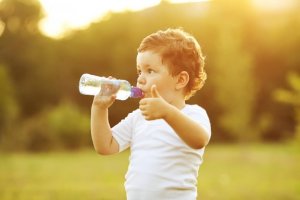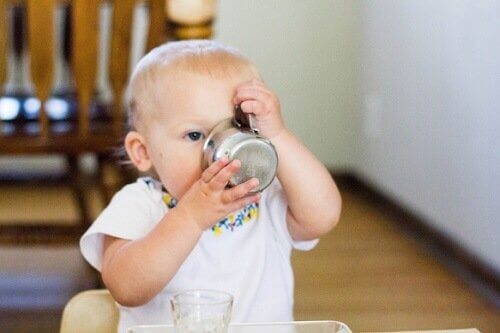When Should You Teach Your Baby to Drink From a Cup?

Babies are constantly taking on what for them are huge challenges, like learning to walk or to drink from a cup. Leaving behind nursing and drinking from a bottle is a psychological, motor, and emotional process, although it may only be for a few minutes a day.
Babies will need to learn to say goodbye to these things that make them feel safe, calm, and happy, which makes putting them aside anything but easy.
When Should You Teach Your Baby to Drink From a Cup?
At 6 months you can begin to let your baby drink water for the first time. Before that age, babies should only drink breast milk. Unless your baby is sick or it’s extremely hot out, you shouldn’t give your baby water before the age of 6 months.
This is when the introduction of complementary nutrition begins. Reduce consumption of breast milk and begin to complement it with water, juice, or cow’s milk. The best way to do this is to teach your child to drink directly from the glass rather than using a bottle.
Until children are 7-8 months old, they certainly won’t have the motor skills or development to pick up the glass, and you’ll have to help.
This process helps your child to begin to mature, somewhat leaving behind the clinginess and dependence created by the connection to the mother’s breast, the bottle, the pacifier, or even a finger.
To start, we recommend using plastic cups with handles and a sippy lid to avoid breaking anything if it gets dropped, or special baby cups that have easy-to-grab shapes.

Some tips
Recommended cups
- Cups made with non-toxic materials. Since glass cups are a bad idea because they’re breakable, silicone is the best choice. This is a rubber material that is tasteless and odorless, without any harmful substances, and able to withstand high heat.
- Choose cups with attractive colors and designs to attract your child’s attention and curiosity.
- Cups with a soft nozzle, also made of silicone.
- Find a cup with an anti-drip lid (to avoid spilling) and handles to grab.
Transitioning between bottle and cup
All kids are different. Each develops at their own rate and in their own way. Motor skills vary among babies, even if they’re the same age.
Parents shouldn’t worry if their baby has trouble using a cup. That being said, most babies are able to drink independently by the time they turn one.
At first, despite the spout, it’s normal for kids to spill and get themselves wet. As drinking water from a cup becomes routine, your child will develop more dexterity until they’re able to drink without spilling a drop.
The “big kid” glass
Around two years old your child should know how to drink from a normal cup, without a spout, which you should progressively remove more and more often.
Final recommendations
- Be patient and always respect the pace of your child’s development.
- Wet the spout of the cup with breast milk and give it to your baby so he’ll associate the taste and smell with nursing. This will help him or her want to drink.
- Switch up what is in the cup. In addition to water, you can try juice and even breast milk.
- Look carefully at the anti-spill nozzles that some cups have. Babies often try to suck and nothing comes out, which frustrates them.
- Teach by modeling for them to imitate.
- Don’t use lids for a long time. Once children can grab the glass, they can try drinking without a lid.
- Be very careful about the cleanliness of the cup and the lid. Small amounts of liquid can get trapped in nooks and crannies and lead to bacterial growth and mold.
Babies are constantly taking on what for them are huge challenges, like learning to walk or to drink from a cup. Leaving behind nursing and drinking from a bottle is a psychological, motor, and emotional process, although it may only be for a few minutes a day.
Babies will need to learn to say goodbye to these things that make them feel safe, calm, and happy, which makes putting them aside anything but easy.
When Should You Teach Your Baby to Drink From a Cup?
At 6 months you can begin to let your baby drink water for the first time. Before that age, babies should only drink breast milk. Unless your baby is sick or it’s extremely hot out, you shouldn’t give your baby water before the age of 6 months.
This is when the introduction of complementary nutrition begins. Reduce consumption of breast milk and begin to complement it with water, juice, or cow’s milk. The best way to do this is to teach your child to drink directly from the glass rather than using a bottle.
Until children are 7-8 months old, they certainly won’t have the motor skills or development to pick up the glass, and you’ll have to help.
This process helps your child to begin to mature, somewhat leaving behind the clinginess and dependence created by the connection to the mother’s breast, the bottle, the pacifier, or even a finger.
To start, we recommend using plastic cups with handles and a sippy lid to avoid breaking anything if it gets dropped, or special baby cups that have easy-to-grab shapes.

Some tips
Recommended cups
- Cups made with non-toxic materials. Since glass cups are a bad idea because they’re breakable, silicone is the best choice. This is a rubber material that is tasteless and odorless, without any harmful substances, and able to withstand high heat.
- Choose cups with attractive colors and designs to attract your child’s attention and curiosity.
- Cups with a soft nozzle, also made of silicone.
- Find a cup with an anti-drip lid (to avoid spilling) and handles to grab.
Transitioning between bottle and cup
All kids are different. Each develops at their own rate and in their own way. Motor skills vary among babies, even if they’re the same age.
Parents shouldn’t worry if their baby has trouble using a cup. That being said, most babies are able to drink independently by the time they turn one.
At first, despite the spout, it’s normal for kids to spill and get themselves wet. As drinking water from a cup becomes routine, your child will develop more dexterity until they’re able to drink without spilling a drop.
The “big kid” glass
Around two years old your child should know how to drink from a normal cup, without a spout, which you should progressively remove more and more often.
Final recommendations
- Be patient and always respect the pace of your child’s development.
- Wet the spout of the cup with breast milk and give it to your baby so he’ll associate the taste and smell with nursing. This will help him or her want to drink.
- Switch up what is in the cup. In addition to water, you can try juice and even breast milk.
- Look carefully at the anti-spill nozzles that some cups have. Babies often try to suck and nothing comes out, which frustrates them.
- Teach by modeling for them to imitate.
- Don’t use lids for a long time. Once children can grab the glass, they can try drinking without a lid.
- Be very careful about the cleanliness of the cup and the lid. Small amounts of liquid can get trapped in nooks and crannies and lead to bacterial growth and mold.
All cited sources were thoroughly reviewed by our team to ensure their quality, reliability, currency, and validity. The bibliography of this article was considered reliable and of academic or scientific accuracy.
- UNICEF. (2014). Guía de pautas de crianza de niños y niñas entre 0 a 5 años. Para agentes formadores de familia. [En línea] Disponible en: https://www.unicef.org/paraguay/spanish/unicef-guiaagentesformadores.pdf
- The Hidden Dangers of Baby Bottles, Pacifiers and Sippy Cups. Time Magazine. 2012. [En línea]. Disponible en: healthland.time.com/2012/05/14/the-hidden-dangers-of-baby-bottles-pacifiers-and-sippy-cups/
This text is provided for informational purposes only and does not replace consultation with a professional. If in doubt, consult your specialist.








